Are you mindful of your calorie intake but still want to enjoy a tasty burger? Look no further! I have the perfect solution for you with my gluten-free bun recipe. These buns are not only delicious but also low in calories, allowing you to indulge guilt-free while maintaining a balanced diet.
Counting calories doesn’t mean you have to sacrifice flavor or satisfaction. With my gluten-free bun recipe, you can enjoy a delicious burger without the worry of excessive calories. These buns are tender, squishy, and hold their shape, providing the perfect base for your favorite burger toppings.
What sets my gluten-free bun recipe apart is its versatility. It can easily accommodate other dietary restrictions, making it ideal for those with specific dietary needs. Whether you’re dairy-free, vegan, or simply looking for a healthier alternative, these buns have got you covered.
Not only are these buns easy to make, but they can also be prepared ahead of time and frozen for future use. This makes them incredibly convenient, especially when you’re in a rush or craving a burger fix. They can even be shaped into smaller sliders or flatter sandwich buns, offering endless possibilities.
The taste and texture of these gluten-free buns are outstanding. They won’t fall apart even with a juicy burger, providing a satisfying dining experience. Say goodbye to crumbly, tasteless gluten-free buns and hello to a bun that fully complements your burger.
To ensure the success of your gluten-free bun recipe, I’ve included key tips for achieving the perfect texture. From using the right ingredients to creating the ideal environment for yeast activation, these tips will help you create buns that are soft, fluffy, and full of flavor.
When it comes to storage, these gluten-free buns can be kept at room temperature for about three days. If you want to extend their shelf life, they can be frozen for up to two months without compromising their taste or texture. This allows you to enjoy homemade gluten-free buns at your convenience.
For those with specific dietary needs, I’ve also provided options for dairy-free and vegan variations. You don’t have to miss out on the deliciousness of these buns just because of your dietary restrictions. With simple ingredient substitutions, you can still enjoy a burger with all the fixings.
Key Takeaways:
- My gluten-free bun recipe is low in calories, allowing you to enjoy a burger without worrying about excessive calorie intake.
- These buns are versatile and can accommodate other dietary restrictions, making them suitable for a variety of dietary needs.
- They can be made ahead of time and frozen for future use, providing convenience and saving you time in the kitchen.
- The taste and texture of these gluten-free buns are exceptional, ensuring a satisfying burger experience.
- Storage options include keeping the buns at room temperature for three days or freezing them for up to two months.
With my gluten-free bun recipe, you can satisfy your burger cravings while maintaining a balanced diet. Don’t let calorie counting stop you from enjoying your favorite foods. Give my recipe a try and discover the deliciousness of homemade gluten-free buns.
Understanding Gluten Free Bun Calories and Nutrition
Before diving into the recipe, let’s take a closer look at the nutritional information and health benefits of gluten-free buns. Whether you have dietary restrictions or simply want to make healthier choices, being aware of the calorie content and nutritional value of your food is essential. With this information, you can enjoy your favorite burger while still staying on track with your calorie goals.
Gluten-free buns vary in calorie count depending on their ingredients and serving size. On average, a gluten-free bun contains around 150-200 calories. These buns are often made with alternative flours such as almond flour, rice flour, or tapioca flour, which can contribute to a slightly higher calorie content compared to traditional wheat-based buns. However, they often offer other nutritional benefits such as being high in fiber and protein, which can help keep you feeling fuller for longer.
When it comes to serving size, it’s important to pay attention to the label or recipe instructions. Some gluten-free buns may be smaller in size, so it’s worth considering if you’ll need to adjust your portion accordingly. Additionally, gluten-free buns can offer various health benefits. They are naturally free from gluten, which is beneficial for individuals with gluten intolerance or celiac disease. They also tend to be lower in carbs and higher in nutrients compared to their wheat-based counterparts.
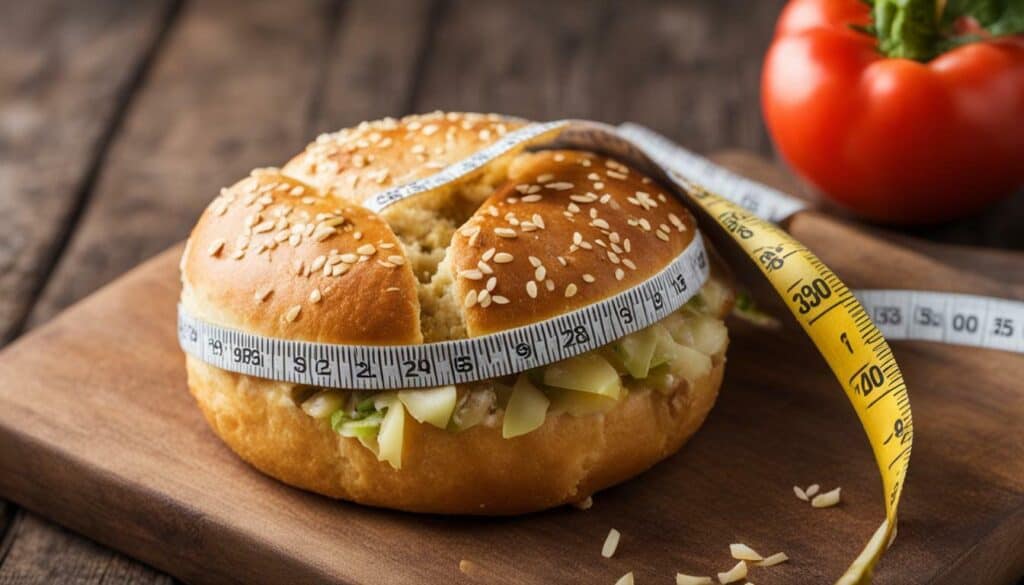
| Calories (per serving) | Fiber (g) | Protein (g) | Fat (g) |
|---|---|---|---|
| 150-200 | 3-5 | 4-7 | 7-10 |
Creating a Low-Calorie Gluten Free Bun
Want to enjoy a guilt-free gluten-free bun? Follow these tips to create a low-calorie version that’s perfect for those watching their calorie intake. These buns are light, fluffy, and packed with flavor, making them a delicious option for any burger. By using alternative ingredients and making a few simple adjustments, you can enjoy a satisfying burger without compromising on taste or texture.
To start, opt for gluten-free flours that are lower in calories, such as almond flour or coconut flour. These alternatives not only reduce the overall calorie content, but they also add a nutty flavor and extra moisture to the buns. You can also add some psyllium husk powder or xanthan gum to help bind the ingredients together and give the buns a chewy texture.
Another key tip is to replace traditional sugar with natural sweeteners like stevia or erythritol. This not only cuts down on calories but also maintains the sweetness without any added sugars. Additionally, using non-dairy milk instead of regular milk reduces the amount of fat and calories in the recipe.
| Ingredient | Calories | Protein (g) | Fat (g) | Carbohydrates (g) |
|---|---|---|---|---|
| Gluten-free flour blend | 120 | 4 | 1 | 25 |
| Almond flour | 90 | 3 | 8 | 3 |
| Coconut flour | 60 | 2 | 3 | 11 |
By making these simple substitutions, you can significantly reduce the calorie content of your gluten-free buns while still enjoying a delicious burger. Experiment with different flour blends and alternative ingredients to find the perfect balance of flavor and nutrition.
To sum up, creating a low-calorie gluten-free bun is easier than you might think. By choosing the right ingredients, such as lower-calorie flours and natural sweeteners, you can enjoy a guilt-free burger without sacrificing taste or texture. Don’t forget to experiment and find the combination that suits your preferences and dietary needs best. So go ahead and indulge in a delicious gluten-free burger with these low-calorie buns!
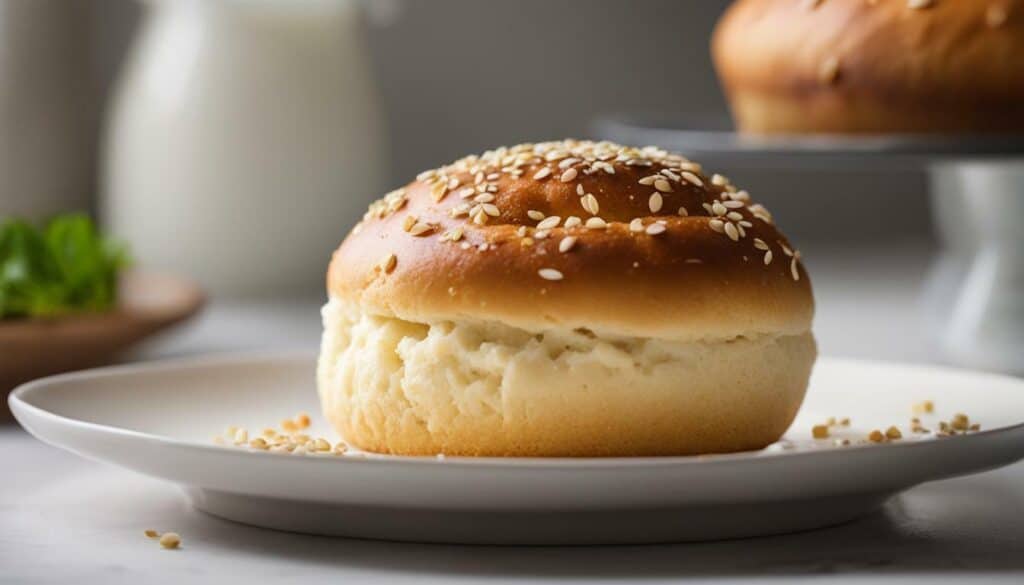
To create the perfect gluten-free bun, it’s important to understand the key ingredients that will give you the best results. Gluten-free flours play a crucial role in achieving the right texture and flavor. A combination of different flours is often used to mimic the structure and elasticity that gluten provides. Common gluten-free flour options include:
- Almond flour: Adds a rich, nutty flavor and helps to bind the ingredients together.
- Brown rice flour: Provides a light and fluffy texture and enhances the overall taste.
- Potato starch: Adds moisture and helps to give the buns a soft, tender crumb.
These flours can be easily found in most grocery stores or specialty shops. It’s important to note that the ratios of these flours may vary depending on the recipe, so it’s best to follow a trusted recipe to ensure successful results.
In addition to the gluten-free flours, other key ingredients include xanthan gum, which helps to improve the texture and bind the dough together, and active dry yeast, which adds the characteristic aroma and flavor of traditional buns. These ingredients, combined with a pinch of salt, sugar, and a source of fat like olive oil or butter, come together to create the perfect gluten-free bun.
| Gluten-Free Flour | Role |
|---|---|
| Almond flour | Rich, nutty flavor and binding agent |
| Brown rice flour | Light and fluffy texture, enhances taste |
| Potato starch | Adds moisture, soft and tender crumb |
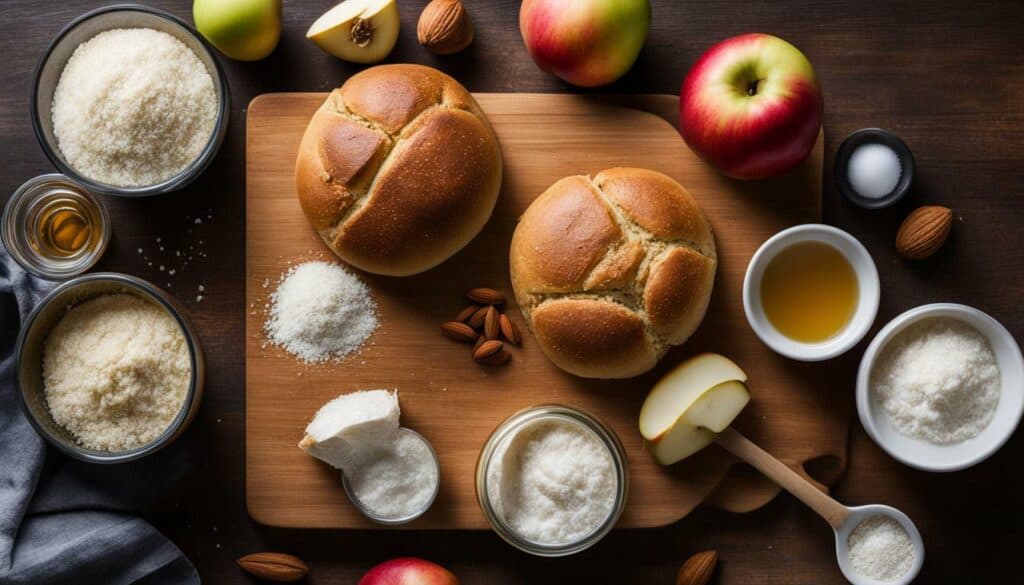
With these key ingredients in your pantry, you’re ready to create delicious gluten-free buns that rival their gluten-filled counterparts. Experiment with different ratios and variations to find the perfect combination that suits your taste buds. Whether you’re following a gluten-free diet or simply looking for a healthier option, these gluten-free buns are sure to satisfy your burger cravings without compromising on flavor or texture.
Achieving the Ideal Texture with Gluten Free Bun Macros
The right balance of macronutrients is crucial in creating gluten-free buns with the perfect texture – soft, tender, and deliciously squishy. Macronutrients, namely protein, fats, and carbohydrates, contribute to the structure and flavor of these buns. To achieve the ideal texture, it’s important to consider the macronutrient composition and make appropriate adjustments in the recipe.
Protein plays a key role in creating structure and elasticity in gluten-free buns. Including high-quality protein sources such as eggs or plant-based protein powders can help achieve the desired texture. These proteins help bind the ingredients together and provide a soft, yet sturdy bun that won’t crumble.
Fats also contribute to the texture and moisture of gluten-free buns. Incorporating healthy fats, such as avocado oil or coconut oil, adds richness and a tender, moist crumb. Balancing the amount of fat in the recipe is important to ensure the buns are not too greasy or dry.
“The right balance of macronutrients is crucial in creating gluten-free buns with the perfect texture – soft, tender, and deliciously squishy.”
Carbohydrates, particularly gluten-free flours, provide structure and volume to the buns. Choosing a blend of gluten-free flours, like almond flour, tapioca flour, or brown rice flour, can help achieve a light and airy texture. It’s essential to follow the recipe measurements precisely to maintain the correct balance of flours and ensure the buns rise properly.
By considering the macronutrient composition of your gluten-free bun recipe and making adjustments as needed, you can create buns with the ideal texture that rival their traditional counterparts. Experiment with different combinations of protein, fats, and carbohydrates to find the perfect balance for your taste preferences. With the right macronutrients, your gluten-free buns will be soft, tender, and incredibly satisfying.
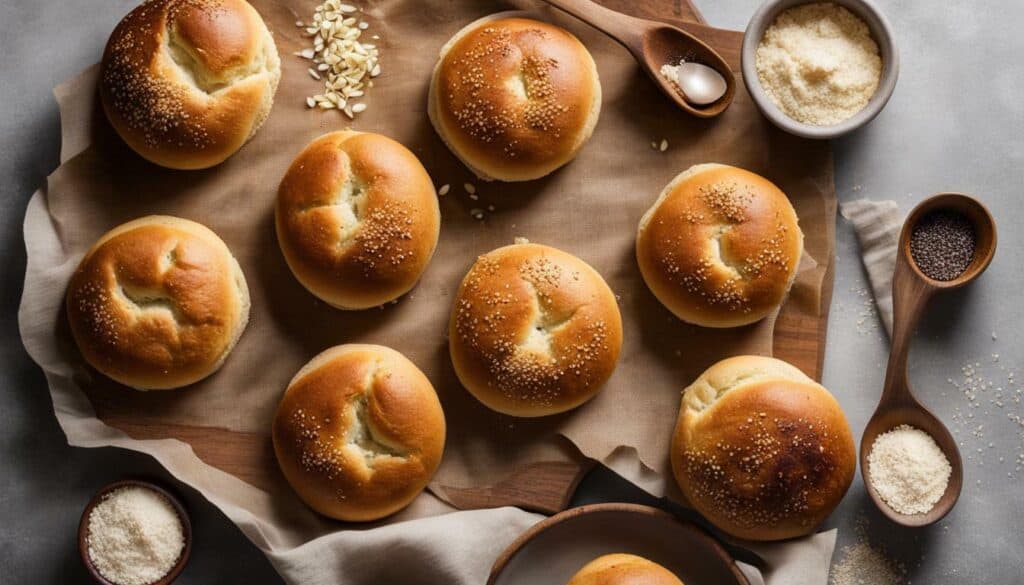
| Macronutrient | Amount per serving |
|---|---|
| Protein | 8g |
| Fat | 12g |
| Carbohydrates | 25g |
| Calories | 200 |
Tips for Success – Activating the Yeast for Perfect Gluten Free Buns
One of the secrets to achieving perfect gluten-free buns lies in properly activating the yeast – follow these tips for success! Yeast is a crucial ingredient that helps the buns rise and creates their soft, fluffy texture. To activate the yeast, you’ll need to create the right environment for fermentation.
First, make sure your yeast is fresh and active. Check the expiration date on the package, and if in doubt, do a quick proofing test. Dissolve a teaspoon of yeast in warm water with a pinch of sugar and wait for it to bubble and froth. If it doesn’t, your yeast may not be alive, and it’s best to start with a fresh batch.
Next, ensure that the water you’re using to activate the yeast is at the right temperature. Too hot, and you’ll kill the yeast; too cold, and it won’t activate. Aim for a temperature between 100-110°F (37-43°C). You can use a kitchen thermometer to get an accurate reading.
Once you’ve activated the yeast, let it sit for about 5-10 minutes until it becomes frothy. This indicates that the yeast is active and ready to be incorporated into the dough. Remember to follow the recipe instructions regarding when to add the yeast, as timing is crucial for achieving the desired results.
Don’t Let Your Yeast Activation Go Wrong
Properly activating the yeast is essential for making sure your gluten-free buns turn out light and airy. While it may seem like a small step, it can make a significant difference in the final result. So take your time, ensure your yeast is fresh, and pay attention to the water temperature. With the right activation, your gluten-free buns will rise beautifully and be the perfect complement to your favorite burger!
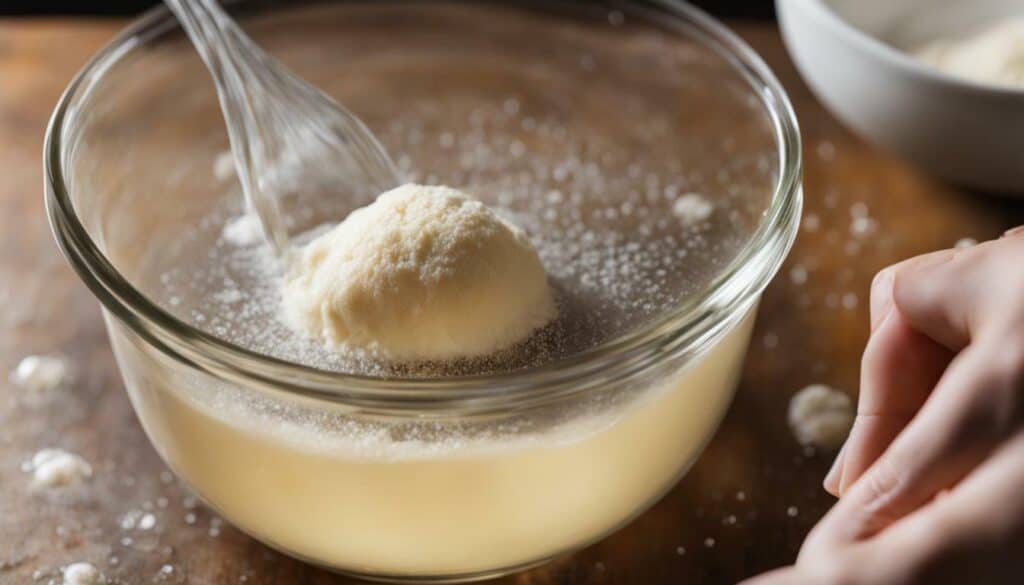
| Tips for Activating Yeast | What to Avoid |
|---|---|
| Check yeast expiration date | Using expired yeast |
| Use warm water (100-110°F / 37-43°C) | Using water that’s too hot or too cold |
| Let yeast sit for 5-10 minutes until frothy | Skipping the yeast activation step |
Make Ahead and Freezing Options for Gluten Free Buns
Meal planning made easy! Discover how you can make gluten-free buns ahead of time and freeze them for future use. These buns are not only delicious but also convenient for busy days when you want a quick and satisfying meal. By preparing a batch of gluten-free buns in advance, you can save time and have a ready-to-use bun whenever you crave a burger or a sandwich.
When making gluten-free buns, it’s best to double the recipe and make a larger batch. This way, you can freeze the extra buns for later use. Simply allow the buns to cool completely, then wrap each bun individually in plastic wrap or place them in a freezer-safe bag. Label the package with the date, and they can be stored in the freezer for up to two months.
To defrost the buns, simply remove them from the freezer and let them thaw at room temperature for a few hours or overnight in the refrigerator. Once thawed, you can lightly toast them or warm them up in a microwave or oven for a few seconds to regain their freshness and softness. The buns will taste just as good as when they were freshly baked!
| Advantages of Making Ahead and Freezing Gluten Free Buns |
|---|
| Convenience: Always have gluten-free buns ready for a quick meal. |
| Time-saving: Prepare a large batch in one go and enjoy them for weeks or months. |
| Cost-effective: Save money by making your own instead of buying pre-packaged gluten-free buns. |
| Customizable: Add your favorite toppings or fillings to the buns before freezing for a personalized touch. |
| Versatile: Use the frozen buns for burgers, sandwiches, sliders, or even as dinner rolls. |
With this make-ahead and freezing technique, you can indulge in gluten-free buns whenever you please without the hassle of starting from scratch every time. It provides the ultimate convenience for those following a gluten-free diet or simply looking for a healthier alternative. So go ahead and give it a try!
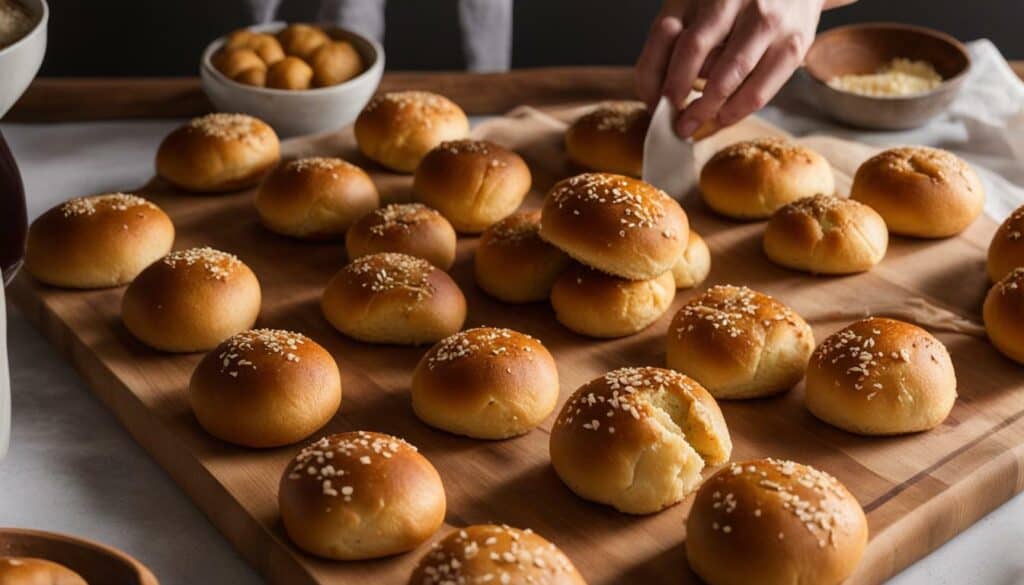
Need a dairy-free or vegan option for your gluten-free buns? No problem! I’ve got you covered with these simple and delicious variations. Whether you have dietary restrictions or just prefer to avoid dairy and animal products, these options will allow you to enjoy the same tasty buns without any compromise.
For a dairy-free version, simply replace the dairy milk in the recipe with your favorite non-dairy alternative, such as almond milk, soy milk, or oat milk. These options will provide the same moisture and texture to the buns without any dairy components. You can also substitute dairy butter with plant-based butter or margarine to achieve the desired richness.
If you’re looking for a vegan option, you’ll need to make a few more adjustments. In addition to the dairy-free substitutes mentioned above, you’ll also need to replace the eggs. One of the best vegan egg replacements for baking is a flaxseed or chia seed egg. To make a flaxseed egg, simply mix 1 tablespoon of ground flaxseeds with 3 tablespoons of water and let it sit for a few minutes until it thickens. This mixture can be used as a replacement for one egg in most recipes.
With these dairy-free and vegan variations, you can enjoy your gluten-free buns without any worries. They will be just as tasty and satisfying as the original recipe. Whether you have dietary restrictions or simply prefer to follow a plant-based diet, these options are a great way to cater to your needs while still enjoying a delicious burger. Give them a try and see how easy it is to adapt the recipe to your specific preferences.
Taste and Texture – The Perfect Gluten Free Bun for Your Burger
Don’t settle for bland or crumbly gluten-free buns – discover the secret to achieving the perfect taste and texture, making them the ideal match for your favorite burger. These gluten-free buns are anything but ordinary. They are soft, fluffy, and packed with flavor, providing a delightful experience with every bite.
What sets these buns apart is their ability to hold up well, even when piled high with a juicy burger and all your favorite toppings. No more worrying about your burger falling apart or the bun disintegrating before you can finish your meal. These gluten-free buns are sturdy enough to handle the juiciest of burgers while maintaining their tender texture.
Using a combination of gluten-free flours and the perfect blend of ingredients, these buns deliver a taste and texture that rivals their gluten-filled counterparts. They are not only delicious but also customizable to suit various dietary needs. Whether you’re lactose intolerant or following a vegan lifestyle, you can easily adapt the recipe to accommodate your preferences.
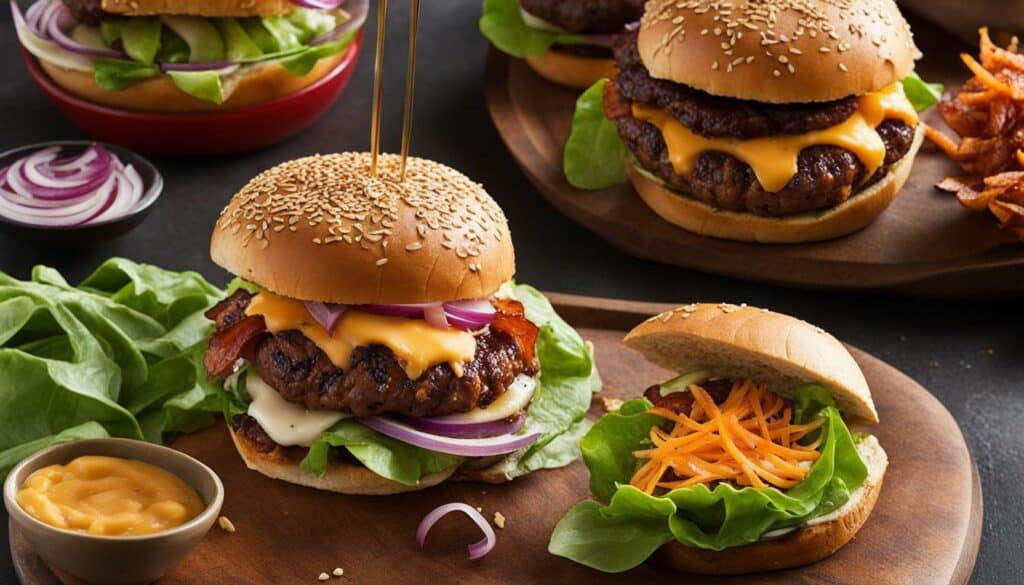
So, if you’ve been on the hunt for a gluten-free bun that satisfies both your taste buds and your burger cravings, look no further. These buns are a game-changer, allowing you to enjoy a burger without compromising on flavor or texture. Say goodbye to disappointment and hello to burger bliss with these perfect gluten-free buns.
Storing and Shelf Life of Gluten Free Buns
Wondering how long your homemade gluten-free buns will stay fresh? Here’s everything you need to know about storing and maximizing their shelf life.
Once your gluten-free buns are baked and cooled, it’s important to store them properly to maintain their freshness. I recommend placing them in an airtight container or resealable bag. This will help protect the buns from air and moisture, which can cause them to become stale or develop an off taste.
At room temperature, gluten-free buns can stay fresh for about three days. However, if you want to extend their shelf life, you can also freeze them. Wrap each bun individually in plastic wrap or place them in separate freezer bags before storing them in the freezer. This will prevent them from sticking together and make it easier to thaw only the amount you need.
When properly stored in the freezer, gluten-free buns can last up to two months. To thaw them, simply transfer the desired number of buns to the refrigerator overnight. If you’re in a hurry, you can also thaw them in the microwave using the defrost setting. Just be careful not to overheat them, as this can lead to a gummy texture.
Whether you enjoy your gluten-free buns fresh or frozen, you’ll love the convenience of having them on hand whenever a burger craving strikes. So go ahead, whip up a batch of these tasty buns and savor every gluten-free bite!
Shelf Life of Gluten Free Buns
| Storage Method | Shelf Life |
|---|---|
| Room Temperature | Approximately 3 days |
| Freezer | Up to 2 months |
Conclusion
With this gluten-free bun recipe, you can enjoy a delicious burger while keeping track of your calorie intake. Say goodbye to compromising flavor and hello to a healthier, satisfying meal!
These homemade gluten-free buns are the perfect option for those who want to count calories without sacrificing taste or texture. They are tender, squishy, and hold their shape, making them ideal for your favorite burger toppings. Whether you’re following a gluten-free diet or simply looking for a lighter alternative, these buns are a game-changer.
Not only are these gluten-free buns easy to make, but they also accommodate other dietary restrictions. You can easily customize the recipe to be dairy-free or vegan, ensuring that everyone can enjoy a burger with their preferred bun. And the best part? You can make these buns ahead of time and freeze them for future use. They’ll stay fresh and flavorful, ready to be toasted and enjoyed whenever you crave a burger.
When it comes to taste and texture, these gluten-free buns deliver. They won’t fall apart, even when paired with a juicy burger. The recipe includes key tips for success, such as activating the yeast properly and using the right ingredients for the ideal balance of macronutrients. Plus, you can store these buns at room temperature for about three days, or freeze them for up to two months.
Don’t let your dietary restrictions limit your burger experience. With this gluten-free bun recipe, you can indulge in a tasty, satisfying meal while staying on track with your calorie goals. So go ahead and fire up the grill, it’s time to enjoy a burger without the guilt!
FAQ
Q: Can I make these gluten-free buns ahead of time and freeze them?
A: Yes, these gluten-free buns can be made ahead of time and frozen. They will remain fresh and delicious for up to two months when properly stored in the freezer.
Q: Can I shape these gluten-free buns into smaller sliders or flatter sandwich buns?
A: Absolutely! These gluten-free buns can be shaped into smaller sliders or flatter sandwich buns to suit your preference or meal needs.
Q: How long can I store these gluten-free buns at room temperature?
A: These gluten-free buns can be stored at room temperature for about three days. Just make sure to keep them in an airtight container or bag to maintain their freshness.
Q: Can I make dairy-free variations of these gluten-free buns?
A: Yes, you can easily make dairy-free variations of these gluten-free buns by using dairy-free milk and choosing dairy-free options for any added toppings or spreads.
Q: Are there vegan options for these gluten-free buns?
A: Absolutely! You can make vegan versions of these gluten-free buns by using plant-based milk and vegan-friendly ingredients for any added toppings or spreads.
How Many Calories are in Steak and Shake Fries?
When it comes to counting calories, it’s important to know the content of your favorite foods. Wondering about the calories in steak and shake fries? Well, these deliciously crispy fries contain approximately 410 calories per serving. Indulge sparingly to maintain a healthy balance in your diet.

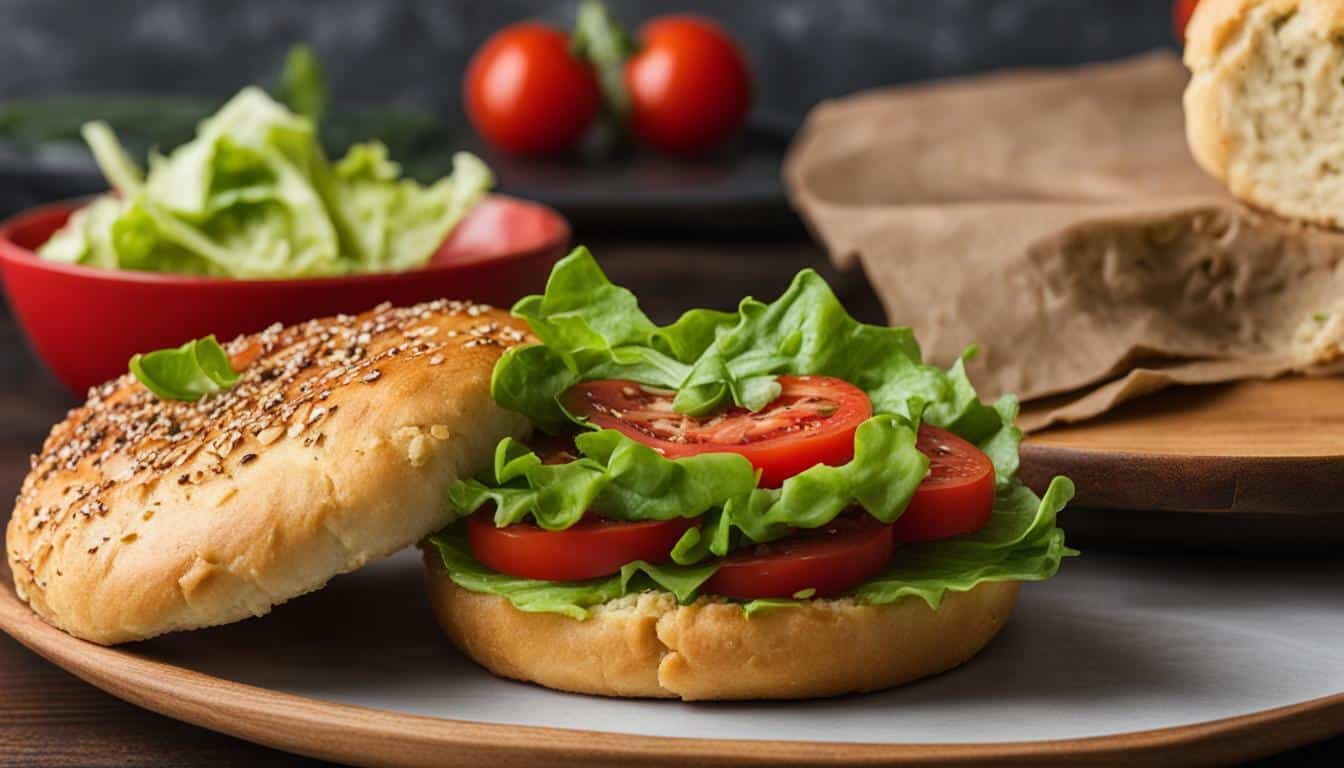



Leave a Reply